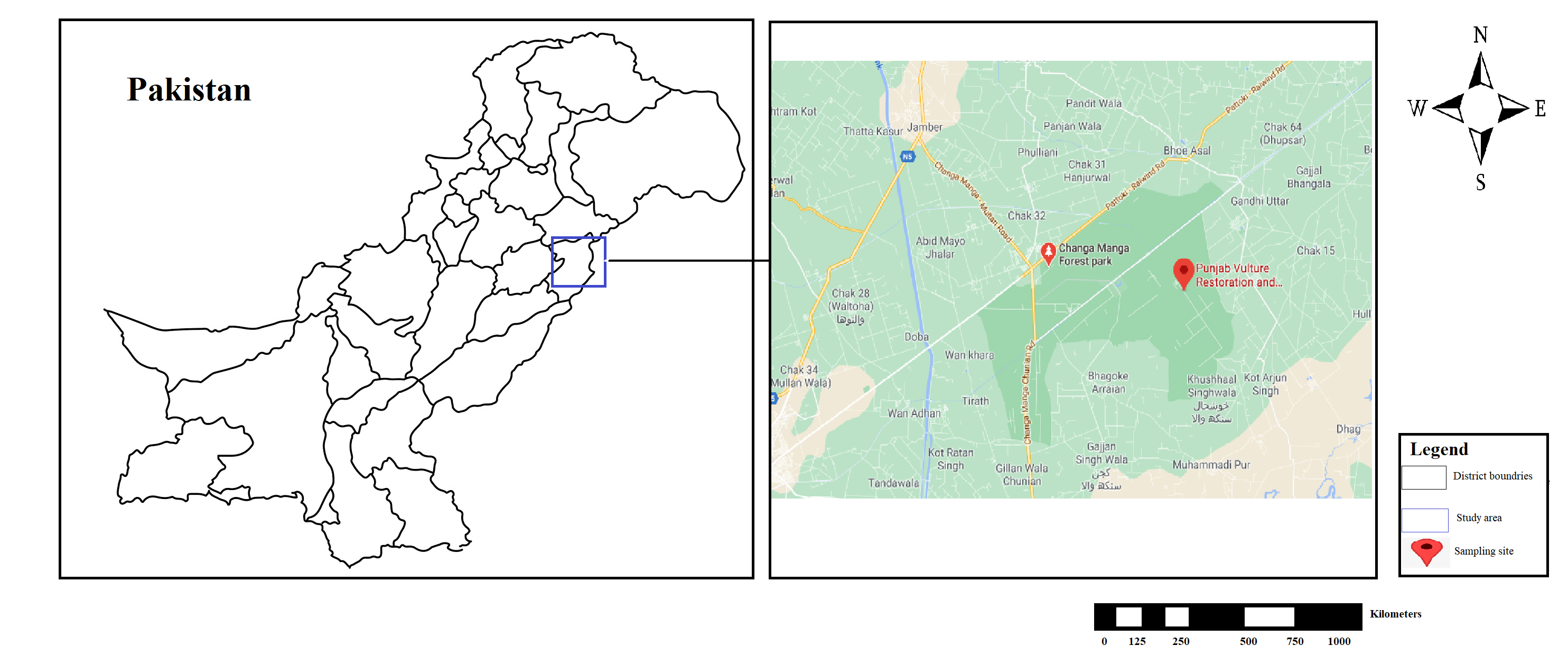The Health Assessment of White-rumped Vultures (Gyps bengalensis) from Changa Manga, Lahore: A Case Study
Abstract
 Abstract Views: 320
Abstract Views: 320
Vultures are considered an important indicator of a healthy environment and they play a vital ecological role as scavengers. The current study was designed to estimate the health of the critically endangered Gyps bengalensis in Changa Manga, Lahore using a technique that does not require drawing blood. Fecal matter of seven pairs was examined and analyzed for protozoan or helminth infections. Gross examination involved checking the consistency and color of feces, presence of blood in feces and gross parasites. Procured samples had different colors and consistency but no blood was found in them. Pair 1 was infested with oocytes; however, in pairs5 and 6 only males were infested, while only the female was infested in Pair 7. Pairs 2, 3, and 4 were completely healthy. Gram staining was also performed to assess the presence or absence of bacteria culture in the digestive tract of Gyps bengalensis. All pairs were either gram-positive or gram-negative except Pair 5, which was negative for all Gram staining. The current work introduces a technique to assess the health of vultures without drawing blood samples, a process that disturbs their life cycle.
Copyright (c) 2021Mafia Ghafoor, Muhammad Xaaceph Khan, Amera Ramzan, Syed Hassan Abbas
Downloads
References
[2] Ogada D, Shaw P, Beyers RL, et al. Another continental vulture crisis: Africa's vultures collapsing toward extinction. Conservation Letters. 2016;9(2):89-97.
[3] McGrady M, Karelus D, Rayaleh H, et al. Home ranges and movements of Egyptian Vultures Neophron percnopterus in relation to rubbish dumps in Oman and the Horn of Africa. Bird Study. 2018;65(4):544-556.
[4] Buechley ER, Şekercioğlu ÇH. The avian scavenger crisis: Looming extinctions, trophic cascades, and loss of critical ecosystem functions. Biol Conserv. 2016;198:220-228.
[5] Mirbahar N, Pakistan I, Ali MH, Saeed A. Facilitation by. 2016;
[6] IUNC. National vulture conservation strategy action plan Pakistan. . 2016;
[7] Loveridge R, Ryan GE, Sum P, et al. Poisoning causing the decline in South-East Asia’s largest vulture population. Bird Conserv Int. 2019;29(1):41-54.
[8] Jimenez-Lopez O, Ponder J, Nault A, Bueno I. Non–Steroidal Anti–Inflammatory Drugs (Nsaids) and Their Effect On Old World Vultures: A Scoping Review. J Raptor Res. 2021;
[9] Gilbert M, Oaks JL, Virani MZ, et al. The status and decline of vultures in the provinces of Punjab and Sind, Pakistan: a 2003 update. Raptors worldwide (Eds: Chancellor, RC & BU Meyburg) World Working Group on Birds of Prey/MME-BirdLife Hungary. 2004:221-234.
[10] Prakash V, Green RE, Pain DJ, et al. Recent changes in populations of resident Gyps vultures in India. J Bombay Nat Hist Soc. 2007;104(2):129-135.
[11] Prakash V, Bishwakarma MC, Chaudhary A, et al. The population decline of Gyps vultures in India and Nepal has slowed since veterinary use of diclofenac was banned. PLoS ONE. 2012;7(11):e49118.
[12] Murn C, Khan U, Farid F. Vulture populations in Pakistan and the Gyps vulture restoration project. Vulture News. 2008;58:35-43.
[13] Borrelli L, Minichino A, Pace A, Dipineto L, Fioretti A. Fecal Sample Collection Method for Wild Birds-Associated Microbiome Research: Perspectives for Wildlife Studies. Animals. 2020;10(8):1349.
[14] Meurs L, Polderman AM, Vinkeles Melchers NV, et al. Diagnosing polyparasitism in a high-prevalence setting in Beira, Mozambique: detection of intestinal parasites in fecal samples by microscopy and real-time PCR. PLoS Negl Trop Dis. 2017;11(1):e0005310.
[15] Owen JP, Nelson AC, Clayton DH. Ecological immunology of bird-ectoparasite systems. Trends in parasitology. 2010;26(11):530-539.
[16] Blanco G. Supplementary feeding as a source of multiresistant Salmonella in endangered Egyptian vultures. Transbound Emerg Dis. 2018;65(3):806-816.
[17] Arshad M, Chaudhary MJ, Wink M. High mortality and sex ratio imbalance in a critically declining Oriental White-backed Vulture population (Gyps bengalensis) in Pakistan. J Ornithol. 2009;150(2):495-503.
[18] Thairu Y, Nasir IA, Usman Y. Laboratory perspective of gram staining and its significance in investigations of infectious diseases. Sub-Saharan African Journal of Medicine. 2014;1(4):168.
[19] Presswell B, Lagrue C. Assessing parasite infections from avian faecal samples: the old methods are still the best. Notornis. 2016;63:32-36.
[20] Gilbert M, Watson RT, Virani MZ, et al. Rapid population declines and mortality clusters in three Oriental white-backed vulture Gyps bengalensis colonies in Pakistan due to diclofenac poisoning. Oryx. 2006;40(4):388-399.

Copyright (c) 2021 Mafia Ghafoor, Muhammad Xaaceph Khan, Amera Ramzan, Syed Hassan Abbas

This work is licensed under a Creative Commons Attribution 4.0 International License.
BSR follows an open-access publishing policy and full text of all published articles is available free, immediately upon publication of an issue. The journal’s contents are published and distributed under the terms of the Creative Commons Attribution 4.0 International (CC-BY 4.0) license. Thus, the work submitted to the journal implies that it is original, unpublished work of the authors (neither published previously nor accepted/under consideration for publication elsewhere). On acceptance of a manuscript for publication, a corresponding author on the behalf of all co-authors of the manuscript will sign and submit a completed the Copyright and Author Consent Form.









